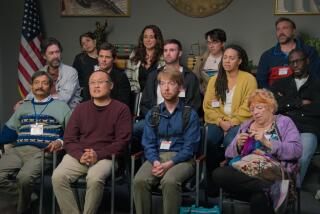When diversity adds fairness
- Share via
The question still plagues many Angelenos: Would the verdict of the racially charged Rodney King trial have been different if the jury had not been predominantly white?
Although social scientists say juries usually manage to produce defensible verdicts, researchers have now found that more diverse juries -- specifically ones that include black and white members -- are more likely to share information, make fewer errors in evaluating the facts and perhaps reach fairer verdicts than all-white juries. The study, conducted with mock jurists, was published in this month’s issue of the Journal of Personality and Social Psychology.
The difference in jury performance could not be attributed solely to the input of minorities, the study found. Sometimes the mere presence of minorities changes the behavior of white jurors.
“I think the traditional perception about diversity is that [it] is going to be a good thing because African Americans will bring something novel to the table,” said Sam Sommers, assistant professor in the Department of Psychology at Tufts University and the study’s author. Although that’s true, he said, “a lot of the results of this study come from white jurors acting differently when they were in diverse groups.”
In short, Sommers said, diversity appears to help members of a group think more deeply and clearly.
“I think the argument could be made that in a homogeneous group, where everyone is like us, it’s easy to be a little lazier, and take those cognitive shortcuts,” he said. “Diversity seems to be one potential way to shake us out of that, and to attend more carefully to our surroundings.”
Janet Schofield, a professor of psychology at the University of Pittsburgh, said the study contradicts the idea of a “colorblind” society. Juries made up of one ethnic group can let stereotypes shape their assumptions, she says, but juries with at least two ethnic groups are more likely to broaden their perspective.
“There is an awareness that other jurors may be watching you and judging you,” said Schofield, who specializes in integration and interracial behavior. “It might make people be, or appear to be, particularly careful. It could be that they really are, or they want to look that way, so they are not open to charges of having been unfair or racist.”
For the study, Sommers recruited 121 people from a jury pool at a courthouse in Washtenaw County, Mich., and 79 people through newspaper advertisements in the same area. All 200 of the study participants were eligible for jury duty. Of the participants, 60% were female and 40% were male; 83% were white and 17% were black. They ranged in age from 18 to 78.
Participants were randomly assigned to 29 six-person juries that were either all white or made up of four whites and two blacks. Most groups had an alternate.
Half the juries received a voir dire questionnaire that asked race-related questions designed to detect racial bias, such as: “Do you have any biases or prejudices that might prevent you from judging an African American defendant fairly?” or “In your opinion, how does the race of a defendant influence the treatment she/he receives in the legal system as a whole?” Voir dire is a court procedure in which potential jurors are asked about personal experiences and attitudes in an attempt to ensure impartiality.
The mock jurors were then shown a 30-minute video summary of the trial of a black defendant charged with sexual assault. The prosecution presented testimony from two victims, neither of whom could identify the assailant’s face, though one could describe a scar on his torso. The core of their case was forensic evidence from semen and hair at the crime scene that were consistent, but not a definitive match, with the defendant. The defense focused on the lack of eyewitness evidence and unreliable methods used by the lab that did the DNA analysis.
At this point -- before deliberations -- the mock jurors were privately polled on whether they believed the defendant was guilty. Of those who were not asked about race during voir dire, 47% said the defendant was guilty while only 34% of those who were asked race-related questions said the defendant was guilty.
The findings suggest that merely asking race-related questions before the trial may remind jurors to keep their minds open and free of prejudice, Sommers said.
In addition, 50% of the participants on the all-white juries said the defendant was guilty before deliberations, while only 34% of the whites in the diverse groups made that judgment.
Sommers’ study did not include an all-black jury. That was partially due to the racial makeup of the area, he says, but also because he chose to focus on the most common categories of jury composition.
“In most jurisdictions in the country, black jurors are the minority,” he said. “That is the typical experience for black jurors.”
In this study, one all-white jury reached a unanimous guilty verdict, 16 groups reached a unanimous not guilty verdict, and 12 groups did not reach a verdict within the one-hour time limit.
But perhaps more interesting than the outcomes was what went on during jury deliberations, which were all taped, coded and analyzed. Only five of the 14 all-white groups mentioned racism during deliberations, and when they did, at least one member played down the issue or tried to change the subject. In the nine racially mixed juries, however, discussion of racism was stifled only twice. Analysis also found that whites in all-white groups made more inaccurate statements than either blacks or whites in diverse groups.
Philip K. Anthony, chief executive of the trial consulting firm DecisionQuest, agreed that members of a diverse jury would reach out more to fellow jurors and make the effort to be understood.
“Fundamentally, when you are part of a diverse group, you have less confidence in the place in society that the others in your group come from,” Anthony said. “As a result, people are instinctively cautious. They want to make sure they are listening to fellow jurors, they want to make comments that are interpreted clearly.”
But, he added, he believes that ultimately jurors do their best to be fair, especially when someone’s life is on the line.
“I disagree that on the basis of ethnicity alone, a panel would be less thorough,” he said. “At least in our collective experience, we have never seen any evidence that panels with greater diversity make better decisions,” said Anthony, whose company has worked on about 12,000 cases over the last 30 years.
He added that panels with greater diversity often end up with greater frustrations during deliberations. “As a result, emotions run high and the decision becomes not necessarily an informed, thought-through decision, but rather one of compromise.”
The mock jury study did not include participants of other races, but Sommers said he suspects results would be similar. Whites are most familiar with being in all-white groups, he said, so the experience of being in a diverse group -- whatever the racial composition -- is influential.
Sommers would not say whether he thought the outcome of L.A.’s King trial would have been different had the jury included more minorities. “This study shows that the demographics of the jury certainly have the potential to lead to different outcomes at trials,” he said. “And diverse juries are better in many respects.”
More to Read
Sign up for Essential California
The most important California stories and recommendations in your inbox every morning.
You may occasionally receive promotional content from the Los Angeles Times.










